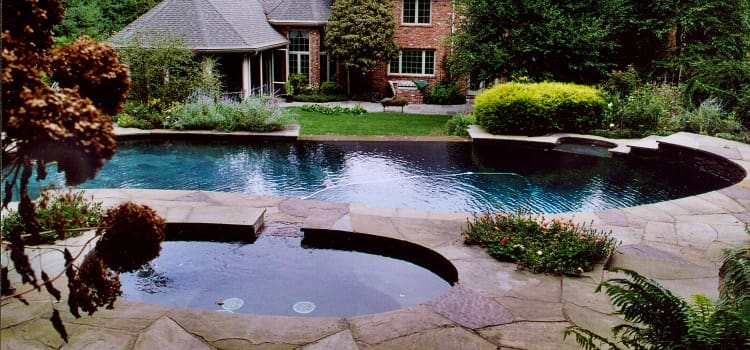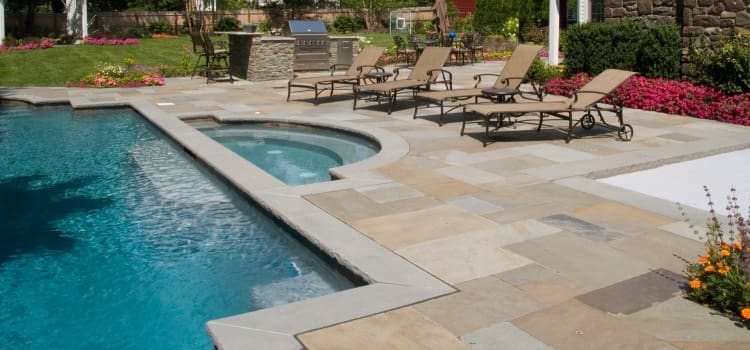Through the years, swimming pool designs have changed to reflect a new generation of homeowners. They aren’t just plain rectangular shapes with white concrete bottoms anymore. Today’s pools are built in a variety of sizes, shapes and styles with beautiful materials and custom features that reflect the architectural style of the house and the beauty of the landscape.
Although many homeowners prefer pools with traditional style and softer shapes, traditional-style pools don’t enhance the sleek style of modern architecture. Modern homes require pool design in NJ that reflects clean edges, straight lines and sharp angles. Take a look at eight modern pool designs and features that complement today’s modern homes.
Infinity Pools
Infinity pools are built with a vanishing or disappearing edge creating an illusion that the water extends beyond the pool’s edges. Infinity pools create a stunning visual effect of infinite space, especially when they are built with an ocean, river or lake view.
In this situation, the infinity edge looks like it merges with the water in the distance creating an endless body of water. In reality, the infinity edge of the pool ends about ¼ inch below the water level, then a barrier is created to spill the pool water into a catch basin and pump it back into the pool.
Although infinity pools create spectacular visual effects that enhance modern pool design in NJ, they are expensive to build. They require a lot of structural support, specialized mechanical hydraulics and unique architectural design details.
If the pool is built in certain locations like cliff overhangs, mountainous landscapes, slopes, hillsides or sandy beach front locations, a geological survey is typically required to make sure the landscape will support the structure. Although infinity pools create breathtaking effects when built near the water, they are just as beautiful in any backyard setting.
Free Form Pools
If you want a modern pool design in NJ with softer edges and a few curves, free form pools offer the perfect design solution. They complement both modern and traditional home styles. Free form swimming pools are designed in a naturalistic or irregular shape and style with curves or flowing lines.
More contemporary free form pools are often designed to resemble natural ponds that you might find in a beautiful, wooded area or garden setting. They often include rock waterfall features, soft underwater lighting and organic, lush landscaping.
The organic shape of a free form pool provides a more relaxed outdoor atmosphere and natural look in the landscape. This is usually accomplished with some combination of the following features:
- Gentle curves
- Non-traditional shapes
- Concrete, flagstone or natural rock around the perimeter
- Natural rock ledges or special features
- Natural landscaping and water plants around the pool
 Lap Pools
Lap Pools
Lap pools provide a great way to get exercise, build muscles and relieve stress. They are long and narrow with straight edges and can be built to any desired length, so they work well in large and small backyards.
Since lap pools are used mostly for swimming, they are typically designed to accommodate only one swimmer, but they can be built to accommodate two or three lanes of swimmers at one time.
Lap pools are long and narrow, so they don’t take up much space in the yard. They provide modern pool design appeal for Bergen County homes with small backyards or homes in urban areas where outdoor space is a commodity.
Lap pools are less expensive to build than more traditional-style pools because they take up less space and require less pool equipment. They can be installed in any backyard with adequate space, as well as indoors for people who want year-round use of their pool.
They can also be insulated, heated and designed to accommodate different water depths. Since most lap pools have fiberglass or vinyl-lined interiors, they can be installed in-ground or above-ground in about three weeks.
Exercise Pools
True exercise pools are different from lap pools because they create a current, unlike lap pools with still water. In an exercise pool the swimmer swims against a current created by resistance jets that allow swimming in place, rather than swimming laps from one end of the pool to the other.
A swimmer can adjust the current in an exercise pool to create more or less resistance for easy or intense workouts. Although the machine that produces the current increases the cost of an exercise pool, many homeowners like swimming in place resistance features for good exercise.
Exercise pools, often called swim-in-place pools or swim spas, require much less length than a regular lap pool. They are typically installed above-ground to allow easier access to the equipment. Putting one in the ground adds to overall costs and makes regular cleaning and maintenance more difficult. Exercise pools offer homeowners a great way to stay fit within small budget and space requirements.
Salt Water Pools
Salt water pools, treated with common salt instead of chlorine, are gaining in popularity with many homeowners as an option to conventional pools. The salt actually converts into chlorine through an electrolysis process that keeps the water sanitized. Salt is added to the pool water on a regular basis, but much less frequently than chlorine requirements in a regular pool. Salt additives also help to reduce maintenance requirements.
If you’re looking for a modern NJ pool design that offers health advantages, a salt water pool is a good choice. The pool contains no harmful chemicals and no chlorine smell. Salt water is much better for your skin, hair and eyes than chlorine.
It does not sting or dry out your skin and mucous membranes like chlorine and other types of pool chemicals. Swimming in a salt water pool is like swimming in a saline bath that leaves your body feeling soft and refreshed.
Sunken Spas
Modern pool designs often include sunken spas, jacuzzis or hot tubs, rather than ones that are attached or elevated above the pool’s surface. They function just like above-pool units, but they are hidden beneath the water.
Sunken spas, often called integrated spas, help to give modern swimming pools straight, clean edges and a level water surface all the way around the pool. The spa can be built into a corner, side, or end of the pool, depending on the pool shape and location of utilities. The pool and spa are separated by a wall that keeps the cold water from the pool from getting into the heated spa.
Although the spa is an integral part of the swimming pool, it can be built in any size or shape. It can also be finished in different materials or plaster color to provide contrast between the pool and spa and give the spa its own distinctive border.
 Glass Pool Fencing
Glass Pool Fencing
If you’re a Bergen County homeowner with a backyard pool, you’re likely concerned about the beauty of your pool and landscape, as well as safety features to keep children and pets out of the pool. Although most current building code regulations require safety fencing around a pool, many pool fencing designs on the market obstruct views from the pool or do little to enhance modern pool design in NJ.
To enhance architectural features and lines on modern homes, frameless glass pool fencing is the perfect solution. It provides a clean, modern appearance that complements modern architecture. Tempered safety glass panels provide wind protection and provide an unobstructed view of your pool surroundings. Glass comes in clear, as well as a range of colored tints and sand blasted patterns that provide privacy and reduce glare.
Fiber-Optic Lighting
If you plan to use your swimming pool at night, proper lighting is essential for pool safety. You can use a floodlight or landscape lighting to illuminate the pool from above, but this isn’t the best or most appealing solution. Fiber optics offer soft, bright lighting for pool design NJ that’s safe for underwater use. Fiber-optic lighting can be decorative as well as functional, creating both a beautiful and safe swimming experience after dark.
Fiber-optic lighting is made from fine strands of glass or plastic. Glass provides brighter light, but plastic is less expensive. Both types transmit light, but not heat or electricity, so they’re completely safe underwater. You can install the illuminator in any remote location, so maintenance is quick and easy.
One of the advantages of fiber-optic pool lighting is design flexibility. You can run the fibers along the perimeter of the pool to create a neon light effect, or place the fibers at different places in the pool to create bright spots of light. You can also use fiber optics to illuminate special features in a pool, such as waterfalls, fountains and adjoining spas or jacuzzis.
If you’re interested in a modern NJ pool design for your Bergen County backyard, contact Borst Landscape & Design. Our professional pool specialists can help you design the perfect swimming pool for your home.

 Glass Pool Fencing
Glass Pool Fencing